Digital Imprints of Personal Heritage: An AI-Driven Analysis of Image Structure, Color, and Content Across Online Communities
Abstract
1. Introduction
2. Materials and Methods
2.1. Participants
2.2. Procedure
- (1)
- Data were obtained from the participants in the community regarding gender and shared images; the objective of the analysis was to characterize the visual components of the images, as these are of great utility in the study of the representation and expression of heritage.
- (2)
- We proceeded to explore the color and structure of the images. The standard protocols for image research were as follows: i.e., the Exif data were analyzed to determine their peculiarities, image format, device, ISO, shutter time, and lens aperture.
- (3)
- The absence of metadata in most of the images led us to refocus our analysis on their content and quantitative aesthetic properties [45]. Our analysis strategy incorporated three complementary approaches: AI (artificial intelligence) for content analysis, color space analysis for aesthetic properties, and statistical testing for relationship verification. For implementation, we used R (v4.3.2; [46]) with the following specialized libraries: tidyverse (v2.0.0; [47]) for data management and ggplot2 (v3.4.4; [48]), reshape2 (v1.4.4; [49]), imager (v0.45.2; [50]), magick (v2.8.1; [51]) and colorspace (v2.1-0; [52]) for visualization and color analysis. Additionally, we employed Python v3.9.18 with pandas (v2.2; [53]) and numpy (v1.26.0; [54]) for data management, matplotlib (v3.7.4; [55]) for graphing, PIL (v10.2.0; [56]) for image processing, and Lavis (v1.0.2; [57]) for multimodal AI implementation.
2.3. Analysis Using Artificial Intelligence
2.4. Classification of Heritage Objects
2.5. Color Analysis
2.6. Data Analysis
3. Results
3.1. Content
3.2. Color
3.3. Saturation
3.4. Structure
4. Discussion
5. Conclusions
Author Contributions
Funding
Data Availability Statement
Conflicts of Interest
Abbreviations
| AI | Artificial Intelligence |
| HLS | Heritage Learning Sequence |
| LAVIS | Language–Vision Instruction for Segmentation |
| BLIP | Bootstrapping Language–Image Pre-Training |
| FlanT5-XL | Flan Text-to-Text Transfer Transformer (Extra Large) |
| RGB | Red–Green–Blue |
| Grad-CAM | Gradient-Weighted Class Activation Mapping |
| CIE-Lab | Commission Internationale de l’Éclairage Lab* |
| CLIP | Contrastive Language–Image Pre-Training |
| ViLT | Vision-and-Language Transformer |
| MMF | Multimodal Framework |
| PIL | Python Imaging Library |
References
- Kumar, T.K.; Nair, R. Conserving knowledge heritage: Opportunities and challenges in conceptualizing cultural heritage information system (CHIS) in the Indian context. Glob. Knowl. Mem. Commun. 2022, 71, 564–583. [Google Scholar] [CrossRef]
- Khalaf, R.W. The Implementation of the UNESCO World Heritage Convention: Continuity and Compatibility as Qualifying Conditions of Integrity. Heritage 2020, 3, 384–401. [Google Scholar] [CrossRef]
- Khalaf, R.W. Continuity: A fundamental yet overlooked concept in World Heritage policy and practice. Int. J. Cult. Policy 2021, 27, 102–116. [Google Scholar] [CrossRef]
- Fontal, O. La Educación Patrimonial Centrada en los Vínculos. El Origami de Bienes, Valores y Personas; Trea: Gijón, Spain, 2022. [Google Scholar]
- Martín Cáceres, M.J.; Cuenca López, J.M. Educomunicación del patrimonio. Educ. Siglo XXI 2015, 33, 33–54. [Google Scholar] [CrossRef][Green Version]
- Fontal, O.; Arias, B.; Ballesteros-Colino, T.; de Castro Martín, P. Conceptualización del patrimonio en entornos digitales mediante referentes identitarios de maestros en formación. Educ. Soc. 2022, 43, 1–26. [Google Scholar] [CrossRef]
- Marín-Cepeda, S.; Fontal, O. La arquitectura del vínculo a través de la web Personas y Patrimonios. OBETS Rev. De Cienc. Soc. 2020, 15, 137–158. [Google Scholar] [CrossRef]
- Piñeiro-Naval, V.; Igartua, J.J.; Rodríguez-de-Dios, I. Identity-related implications of the dissemination of cultural heritage through the Internet: A study based on Framing Theory. Commun. Soc. 2018, 31, 1–21. [Google Scholar] [CrossRef]
- Poong, Y.S.; Yamaguchi, S.Y.; Takada, J.-i. Analysing Mobile Learning Acceptance in the World Heritage Town of Luang Prabang, Lao PDR. In Mobile Learning in Higher Education in the Asia-Pacific Region. Education in the Asia-Pacific Region: Issues, Concerns and Prospects; Murphy, A., Farley, H., Dyson, L., Jones, H., Eds.; Springer: Singapore, 2017; Volume 40. [Google Scholar] [CrossRef]
- Castro-Calviño, L.; Rodríguez-Medina, J.; López-Facal, R. Educación patrimonial para una ciudadanía participativa. Evaluación de resultados de aprendizaje del alumnado en el programa Patrimonializarte. Rev. Electrónica Interuniv. Form. Profr. 2021, 24, 205–219. [Google Scholar] [CrossRef]
- Luna, U.; Ibáñez-Etxeberria, A.; Rivero, P. El patrimonio aumentado. 8 apps de Realidad Aumentada para la enseñanza-aprendizaje del patrimonio. Rev. Interuniv. Form. Profr. 2018, 3, 43–62. [Google Scholar]
- Luna, U.; Rivero, P.; Vicent, N. Augmented reality in heritage apps: Current trends in Europe. Appl. Sci. 2019, 9, 2756. [Google Scholar] [CrossRef]
- Ibáñez-Exeberria, A.; Kortabitarte, A.; De Castro, P.; Gillate, I. Digital competence using heritage theme apps in the DigComp framework. Rev. Interuniv. Form. Profr. 2019, 22, 13–27. [Google Scholar] [CrossRef]
- Narváez-Montoya, A. Comunicación educativa, educomunicación y educación mediática: Una propuesta de investigación y formación desde un enfoque culturalista. Palabra Clave 2019, 22, e22311. [Google Scholar] [CrossRef]
- Mason, M. The dimensions of the mobile visitor experience: Thinking beyond the technology design. Int. J. Incl. Mus. 2013, 5, 51–72. [Google Scholar] [CrossRef]
- Comes, P. ¿Cómo Pueden Ayudarnos las Nuevas Tecnologías a Desarrollar la Identidad Ciudadana? Rastres, un Ejemplo de Aplicación Didáctica Multimedia con Vocación Cívica. En Identidades y Territorios: Un Reto Para la Didáctica de las Ciencias Sociales; Asociación Universitaria de Profesores de Didáctica de las Ciencias Sociales: Madrid, Spain, 2001; pp. 529–538. [Google Scholar]
- Costa, E. Affordances-in-practice: An ethnographic critique of social media logic and context collapse. New Media Soc. 2018, 20, 3641–3656. [Google Scholar] [CrossRef] [PubMed]
- Sun, Y.; Suthers, D.D. Cultural affordances and social media. In Proceedings of the Annual Hawaii International Conference on System Sciences, Kauai, HI, USA, 5–8 January 2021; pp. 3017–3026. [Google Scholar] [CrossRef]
- Guilbeault, D.; Delecourt, S.; Hull, T.; Desikan, B.S.; Chu, M.; Nadler, E. Online images amplify gender bias. Nature 2024, 626, 1049–1055. [Google Scholar] [CrossRef] [PubMed]
- De Castro Martín, P.; Sánchez-Macías, I. #Souvenirs1936. Transmedia y procesos de identización en el aprendizaje de la Guerra Civil Española. Rev. Interuniv. Form. Profr. 2019, 94, 63–82. [Google Scholar]
- Vassilakis, C.; Antoniou, A.; Lepouras, G.; Poulopoulos, V.; Wallace, M.; Bampatzia, S.; Bourlakos, I. Stimulation of Reflection and Discussion in Museum Visits Through the Use of Social Media; Social Network Analysis and Mining: Heidelberg, Germany, 2017; Volume 7. [Google Scholar] [CrossRef]
- Fontal, O. (Coord.). La Educación Patrimonial. Del Patrimonio a las Personas; Trea: Gijón, Spain, 2013. [Google Scholar]
- Gómez Redondo, C.; Fontal Merillas, O.; Ibáñez-Exeberría, A. Procesos de patrimonialización en el arte contemporáneo. EARI Educ. Artística Rev. Investig. 2016, 2, 108–112. [Google Scholar] [CrossRef]
- Rose, G. Visual Methodologies: An Introduction to Researching with Visual Materials, 5th ed.; SAGE Publications Ltd.: Thousand Oaks, CA, USA, 2023. [Google Scholar]
- Pink, S. (Ed.) Advances in Visual Methodology; SAGE Publications Ltd.: Thousand Oaks, CA, USA, 2012. [Google Scholar]
- Mitchell, C.; Lange, N.; Moletsane, R. Participatory Visual Methodologies; SAGE Publications Ltd.: Thousand Oaks, CA, USA, 2018. [Google Scholar] [CrossRef]
- Wee, B.; DePierre, A.; Anthamatten, P.; Barbour, J. Visual methodology as a pedagogical research tool in geography education. J. Geogr. High. Educ. 2013, 2, 164–173. [Google Scholar] [CrossRef]
- Talsi, R.; Laitila, A.; Joensuu, T.; Saarinen, E. The Clip Approach: A Visual Methodology to Support the (Re)Construction of Life Narratives. Qual. Health Res. 2021, 31, 789–803. [Google Scholar] [CrossRef]
- Martins, H. For a visual anthropology of tourism: The critical use of methodologies and visual materials. PASOS Rev. Tur. Patrim. Cult. 2016, 14, 527–541. [Google Scholar] [CrossRef]
- Bradley, J. Building a visual vocabulary: The methodology of ‘reading’ images in context. In Approaching Methodology; Latvala, F.P., Leslie, H.F., Eds.; Annales Academiæ Scientiarum Fennicæmia: Helsinki, Finland, 2013; Volume 368, pp. 83–98. [Google Scholar]
- Graziano, T. The insiders’ gaze: Fieldworks, social media and visual methodologies in urban tourism. AIMS Geosci. 2022, 8, 366–384. [Google Scholar] [CrossRef]
- Bell, V. Visual Methodologies and Photographic Practices: Encounters with Hadrian’s Wall World Heritage Site. In Tourism and Visual Culture; Burns, P.M., Lester, J.A., Bibbings, L., Eds.; CABI: Oxfordshire, UK, 2010; Volume 2, pp. 120–134. [Google Scholar] [CrossRef]
- Savin, P.; Trandabat, D. Ethnolinguistic Audio-visual Atlas of the Cultural Food Heritage of Bacău County—Elements of methodology. BRAIN Broad Res. Artif. Intell. Neurosci. 2018, 9, 125–131. [Google Scholar]
- Huebner, E.J. TikTok and museum education: A visual content analysis. Int. J. Educ. Through Art 2022, 18, 209–225. [Google Scholar] [CrossRef]
- Pietroni, E.; Ferdani, D. Virtual Restoration and Virtual Reconstruction in Cultural Heritage: Terminology, Methodologies, Visual Representation Techniques and Cognitive Models. Information 2021, 12, 167. [Google Scholar] [CrossRef]
- Wang, M.; Zhao, M.T.; Lin, M.L.; Cao, W.; Zhu, H.L.; An, N. Seeking lost memories: Application of a new visual methodology for heritage protection. Geogr. Rev. 2020, 110, 41–55. [Google Scholar] [CrossRef]
- Gattiglia, G. Managing artificial intelligence in archeology. an overview. J. Cult. Herit. 2025, 71, 225–233. [Google Scholar] [CrossRef]
- Fontal, O. La Educación Patrimonial: Teoría y Práctica en el Aula, el Museo e Internet; Trea: Gijón, Spain, 2003. [Google Scholar]
- Fontal Merillas, O.; De Castro Martín, P. El patrimonio cultural en la educación artística: Del análisis del currículum a la mejora de la formación inicial del profesorado en Educación Primaria. Arte Individuo Soc. 2023, 35, 461–481. [Google Scholar] [CrossRef]
- Falcon, R.; Fontal Merillas, O.; Torregrosa, A. Le patrimoine comme don du temps. Sociétés 2015, 129, 115–124. [Google Scholar] [CrossRef]
- Clough, P.; Goodley, D.; Lawthom, R.; Moore, M. Researching Life Stories. Method, Theory and Analysis in a Biographical Age; Routledge: Oxfordshire, UK, 2004. [Google Scholar]
- Kress, G. Literacy in the New Media; Routledge: Oxfordshire, UK, 2003. [Google Scholar]
- Kress, G.; Van Leeuwen, T. Reading Images. The Grammar of Visual Design; Routledge: Oxfordshire, UK, 2006. [Google Scholar]
- Camgöz, N.; Yener, C.; Güvenç, D. Effects of hue, saturation, and brightness on preference. Color Res. Appl. 2002, 27, 199–207. [Google Scholar] [CrossRef]
- Mather, G. Aesthetic Image Statistics Vary with Artistic Genre. Vision 2020, 4, 10. [Google Scholar] [CrossRef]
- R Core Team. R: A Language and Environment for Statistical Computing. R Foundation for Statistical Computing; R Core Team: Vienna, Austria, 2023; Available online: https://www.R-project.org/ (accessed on 19 December 2024).
- Wickham, H.; Averick, M.; Bryan, J.; Chang, W.; McGowan, L.D.; François, R.; Grolemund, G.; Hayes, A.; Henry, L.; Hester, J.; et al. Welcome to the tidyverse. J. Open Source Softw. 2019, 4, 1686. [Google Scholar] [CrossRef]
- Wickham, H. ggplot2: Elegant Graphics for Data Analysis; Springer: Cham, Switzerland, 2016. [Google Scholar]
- Wickham, H. Reshaping Data with the reshape Package. J. Stat. Softw. 2007, 21, 1–20. [Google Scholar] [CrossRef]
- Barthelme, S. Imager: Image Processing Library Based on ‘CImg’, R Package Version 0.45.2; CRAN: Vienna, Austria, 2023; Available online: https://CRAN.R-project.org/package=imager (accessed on 19 December 2024).
- Ooms, J. Magick: Advanced Graphics and Image-Processing in R, R Package Version 2.8.1; CRAN: Vienna, Austria, 2023; Available online: https://CRAN.R-project.org/package=magick (accessed on 19 December 2024).
- Zeileis, A.; Fisher, J.C.; Hornik, K.; Ihaka, R.; McWhite, C.D.; Murrell, P.; Stauffer, R.; Wilke, C.O. Colorspace: A Toolbox for Manipulating and Assessing Colors and Palettes. J. Stat. Softw. 2020, 96, 1–49. [Google Scholar] [CrossRef]
- Zenodo. The Pandas Development Team. Pandas-Dev/Pandas: Pandas (v2.2.0rc0). 2023. Available online: https://doi.org/10.5281/zenodo.10426137 (accessed on 20 December 2024).
- Harris, C.R.; Millman, K.J.; van der Walt, S.J.; Gommers, R.; Virtanen, P.; Cournapeau, D.; Wieser, E.; Taylor, J.; Berg, S.; Smith, N.J.; et al. Array programming with NumPy. Nature 2020, 585, 357–362. [Google Scholar] [CrossRef] [PubMed]
- Caswell, T.A.; Sales de Andrade, E.; Lee, A.; Droettboom, M.; Hoffmann, T.; Klymak, J.; Hunter, J.; Firing, E.; Stansby, D.; Varoquaux, N.; et al. Matplotlib/Matplotlib: REL v3.7.4; Zenodo: Geneva, Switzerland, 2023. [Google Scholar] [CrossRef]
- Clark, A. Pillow (PIL Fork) Documentation; Readthedocs: Portland, OR, USA, 2015; Available online: https://buildmedia.readthedocs.org/media/pdf/pillow/latest/pillow.pdf (accessed on 15 December 2024).
- Du, Y.; Liu, Z.; Li, J.; Zhao, W.X. A survey of vision-language pre-trained models. arXiv 2022, arXiv:2202.10936. [Google Scholar]
- Li, D.; Li, J.; Le, H.; Wang, G.; Savarese, S.; Hoi, S.C.H. LAVIS: A Library for Language-Vision Intelligence. arXiv 2022, arXiv:2209.09019. [Google Scholar] [CrossRef]
- Kong, A.; Zhao, S.; Chen, H.; Li, Q.; Qin, Y.; Sun, R.; Zhou, X.; Wang, E.; Dong, X. Better zero-shot reasoning with role-play prompting. arXiv 2023, arXiv:2308.07702. [Google Scholar]
- Chang, W.; Cheng, J.; Allaire, J.; Sievert, C.; Schloerke, B.; Xie, Y.; Allen, J.; McPherson, J.; Dipert, A.; Borges, B. Shiny: Web Application Framework for R; R Package Version 1.8.0; CRAN: Vienna, Austria, 2023; Available online: https://CRAN.R-project.org/package=shiny (accessed on 11 November 2024).
- Hill, B.; Roger, T.; Vorhagen, F.W. Comparative analysis of the quantization of color spaces on the basis of the CIELAB color-difference formula. ACM Trans. Graph. 1997, 16, 109–154. [Google Scholar] [CrossRef]
- Jain, A.K. Fundamentals of Digital Image Processing; Prentice-Hall, Inc.: Hoboken, NJ, USA, 1989. [Google Scholar]
- Hasler, D.; Süsstrunk, S.E. Measuring colorfulness in natural images. In Human Vision and Electronic Imaging VIII; SPIE: Bellingham, WA, USA, 2003; Volume 5007, pp. 87–95. [Google Scholar]
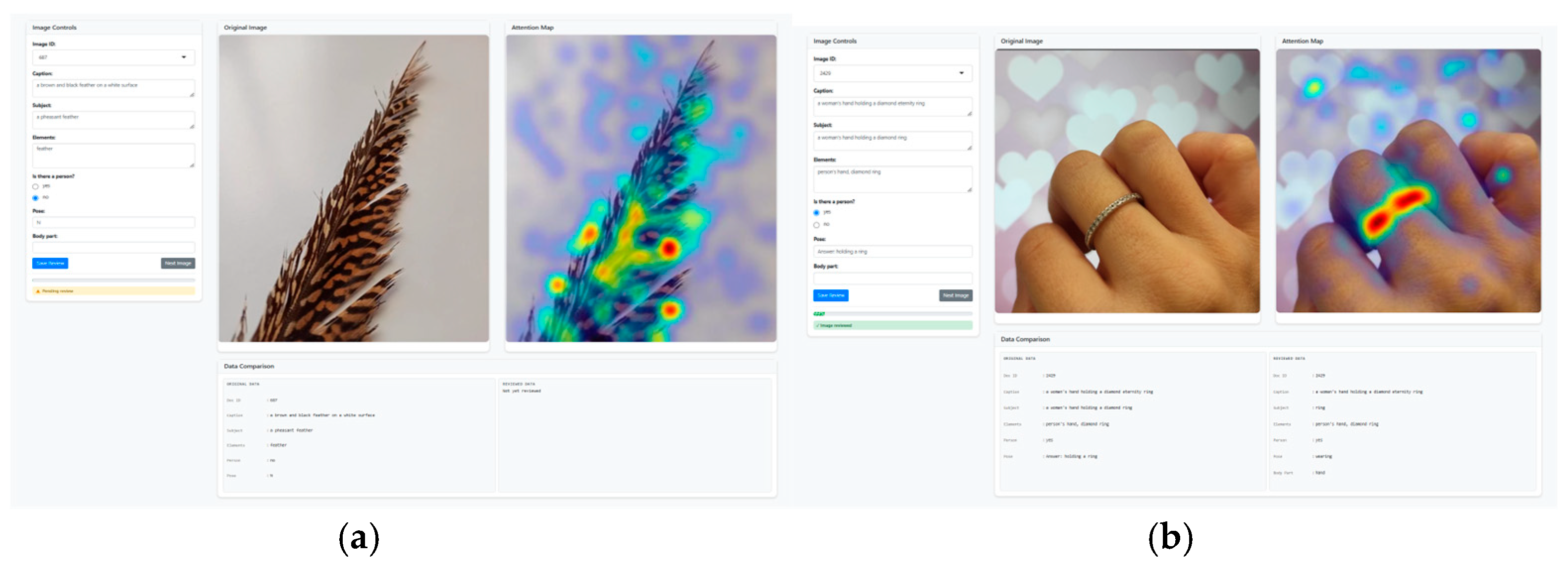

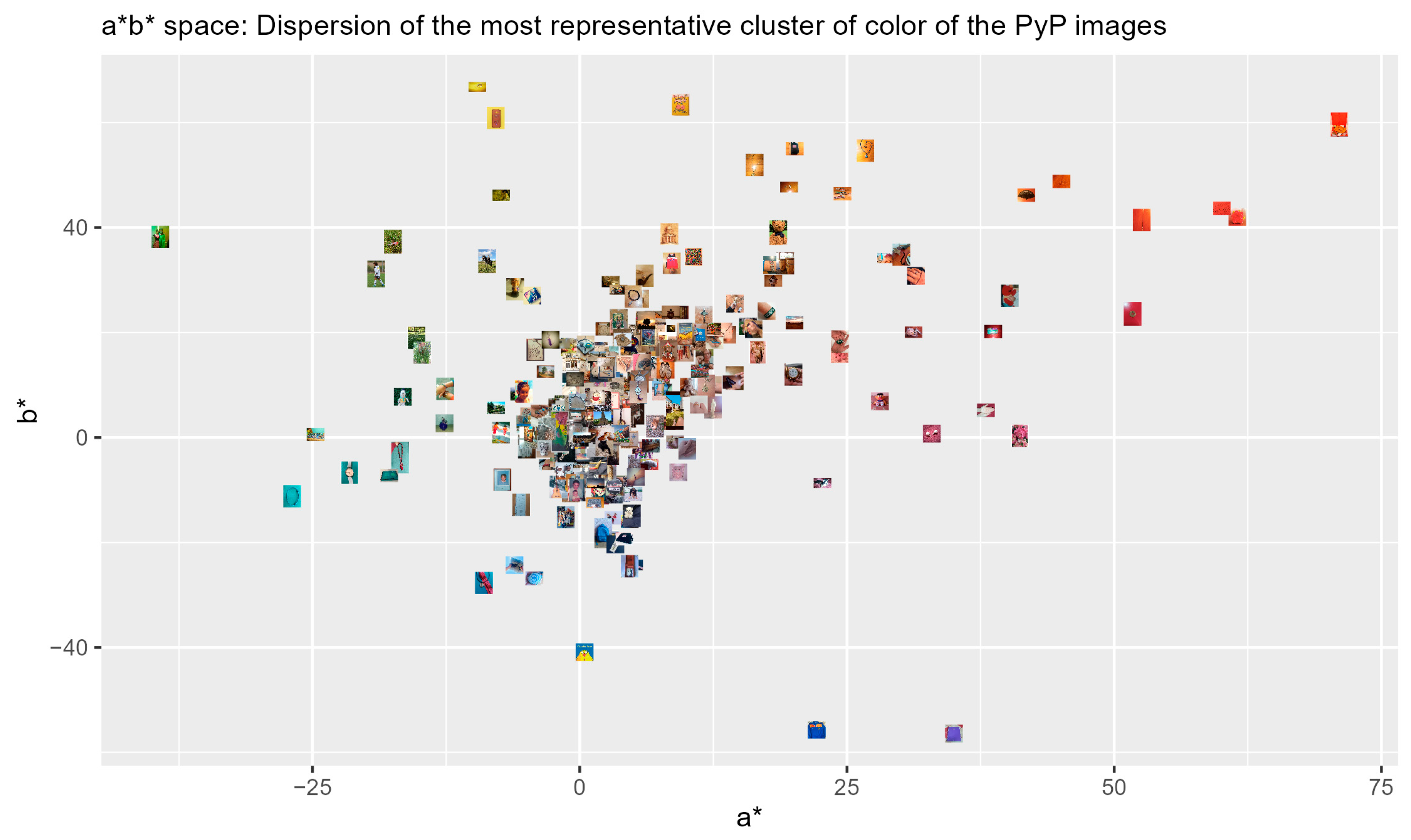

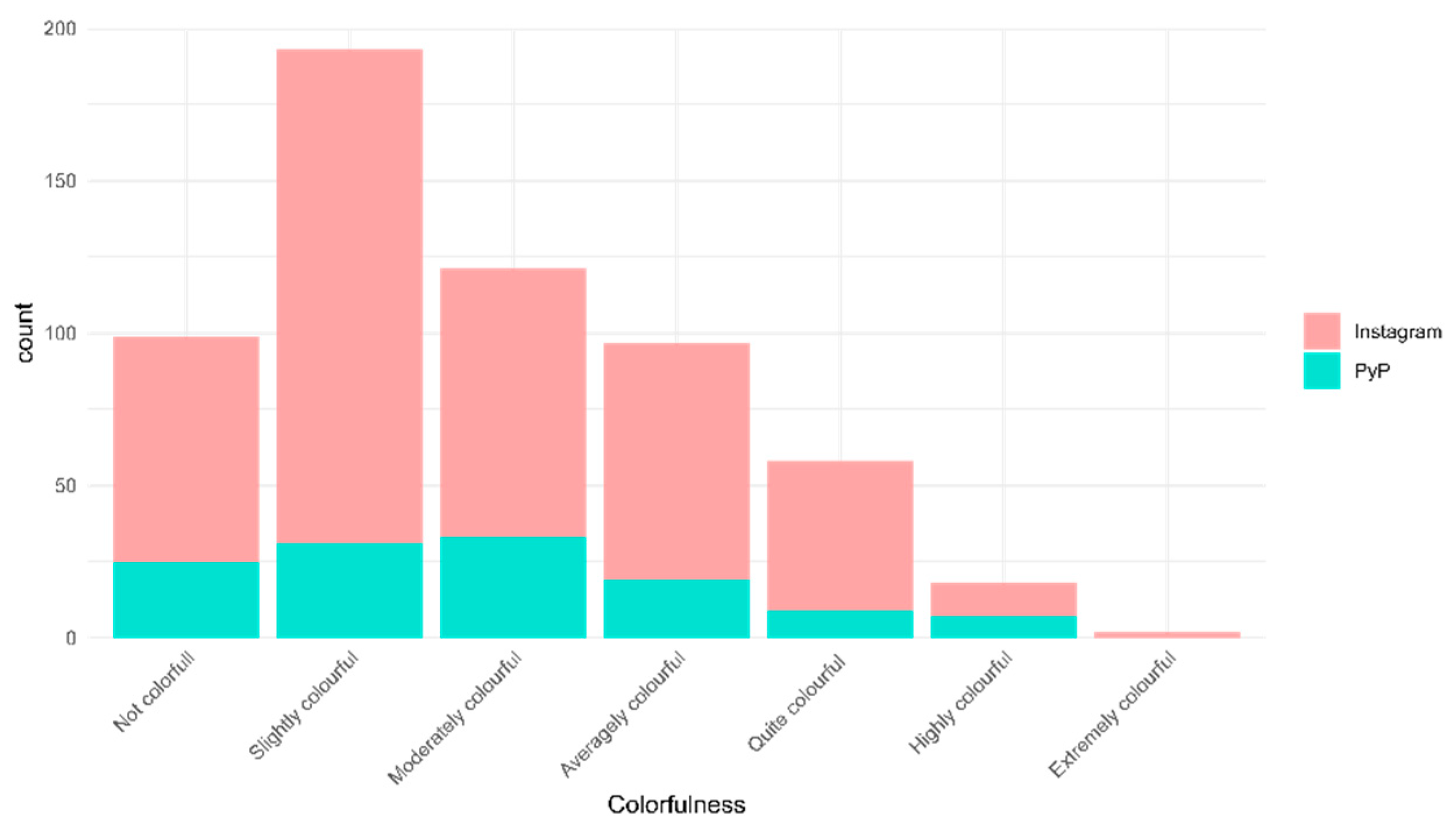
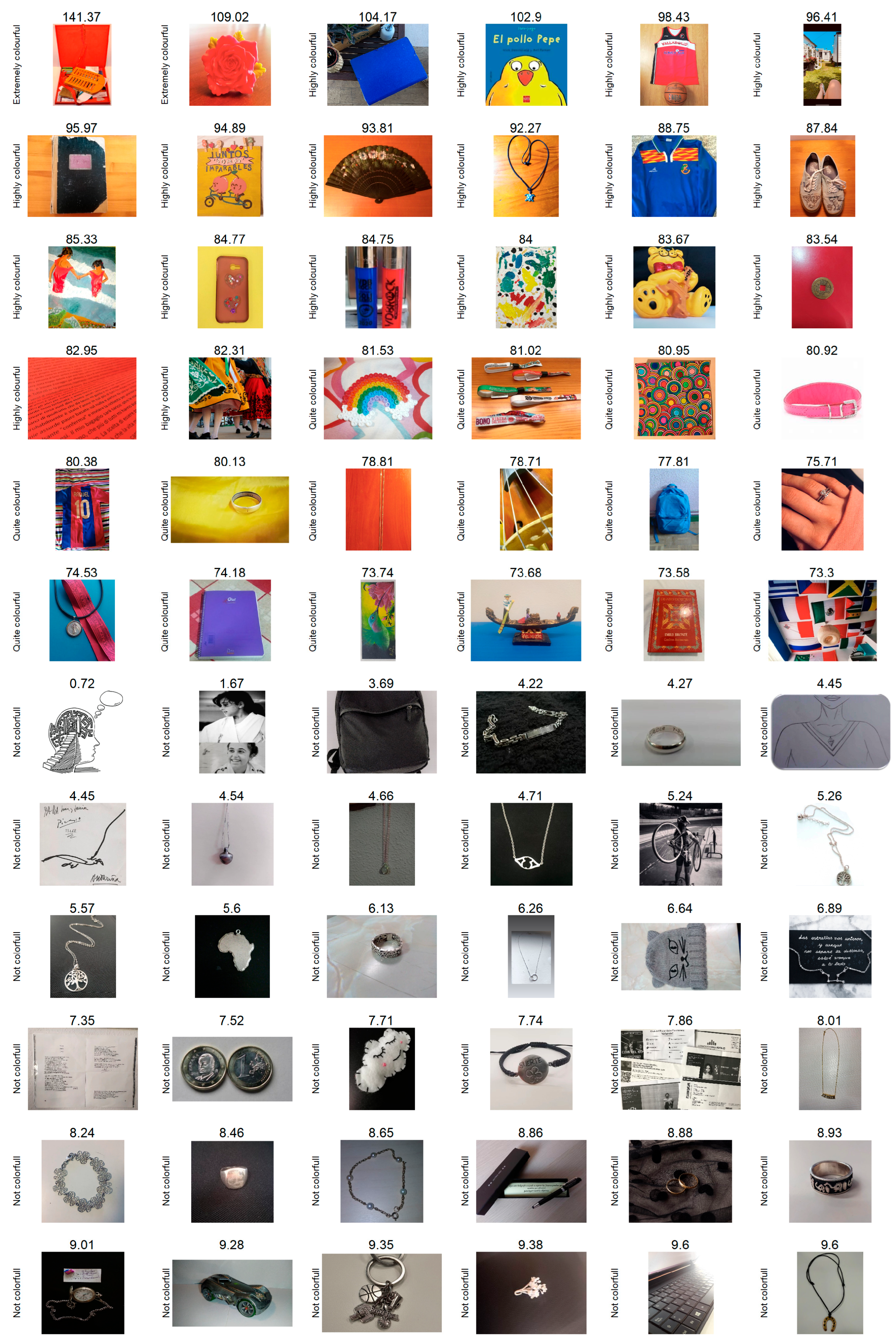
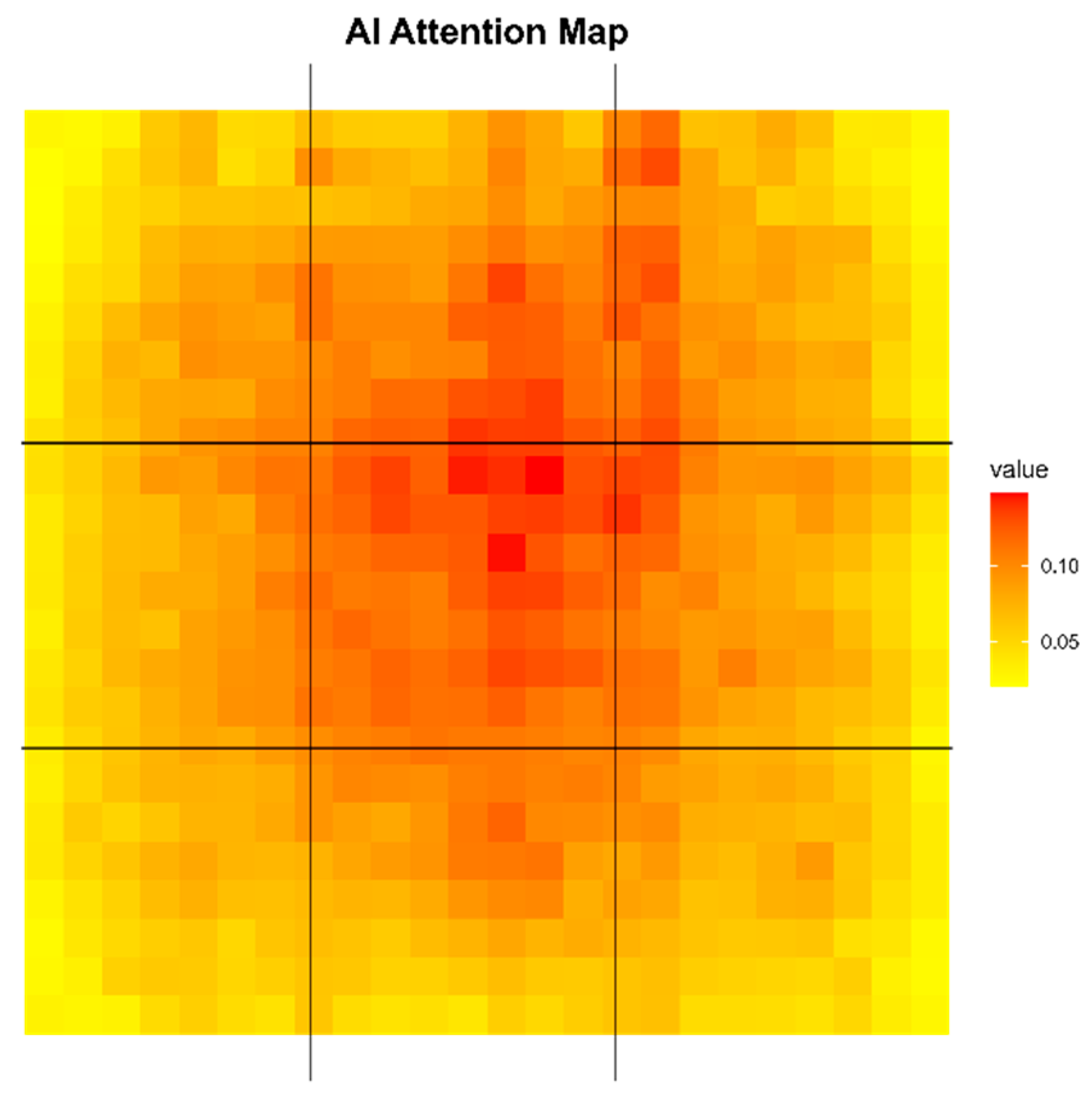

| Object | N |
|---|---|
| bracelet | 36 |
| necklace | 34 |
| ring | 34 |
| landscape | 24 |
| stuffed animal | 24 |
| book | 20 |
| tattoo | 16 |
| box | 13 |
| drawing | 13 |
| photo | 13 |
| Action | N |
|---|---|
| Holding | 32 |
| Carrying | 29 |
| Standing | 22 |
| Showing | 17 |
| Sitting | 7 |
| Playing | 4 |
| Smiling | 4 |
| Lying | 3 |
Disclaimer/Publisher’s Note: The statements, opinions and data contained in all publications are solely those of the individual author(s) and contributor(s) and not of MDPI and/or the editor(s). MDPI and/or the editor(s) disclaim responsibility for any injury to people or property resulting from any ideas, methods, instructions or products referred to in the content. |
© 2025 by the authors. Licensee MDPI, Basel, Switzerland. This article is an open access article distributed under the terms and conditions of the Creative Commons Attribution (CC BY) license (https://creativecommons.org/licenses/by/4.0/).
Share and Cite
Gil-Biraud, V.E.; de Castro Martín, P.; Fontal Merillas, O. Digital Imprints of Personal Heritage: An AI-Driven Analysis of Image Structure, Color, and Content Across Online Communities. Heritage 2025, 8, 390. https://doi.org/10.3390/heritage8090390
Gil-Biraud VE, de Castro Martín P, Fontal Merillas O. Digital Imprints of Personal Heritage: An AI-Driven Analysis of Image Structure, Color, and Content Across Online Communities. Heritage. 2025; 8(9):390. https://doi.org/10.3390/heritage8090390
Chicago/Turabian StyleGil-Biraud, Victor Enrique, Pablo de Castro Martín, and Olaia Fontal Merillas. 2025. "Digital Imprints of Personal Heritage: An AI-Driven Analysis of Image Structure, Color, and Content Across Online Communities" Heritage 8, no. 9: 390. https://doi.org/10.3390/heritage8090390
APA StyleGil-Biraud, V. E., de Castro Martín, P., & Fontal Merillas, O. (2025). Digital Imprints of Personal Heritage: An AI-Driven Analysis of Image Structure, Color, and Content Across Online Communities. Heritage, 8(9), 390. https://doi.org/10.3390/heritage8090390








